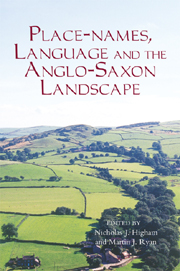Book contents
- Frontmatter
- Contents
- List of Illustrations
- Acknowledgements
- List of Contributors
- Abbreviations
- 1 Place-Names, Language and the Anglo-Saxon Landscape: An Introduction
- 2 The Landscape of Place-Name Studies
- 3 Place-Names as Travellers' Landmarks
- 4 Light thrown by Scandinavian Place-Names on the Anglo-Saxon Landscape
- 5 Language and the Anglo-Saxon Landscape: Towards an Archaeological Interpretation of Place-Names in Wiltshire
- 6 Hunting the Vikings in South Cumbria from Ambleside to Haverbrack
- 7 Viking-Age Amounderness: A Reconsideration
- 8 The Woodland Landscape of Early Medieval England
- 9 The Pre-Conquest Lands and Parish of Crediton Minster, Devon
- 10 Rewriting the Bounds: Pershore's Powick and Leigh
- 11 That ‘Dreary Old Question’: The Hide in Early Anglo-Saxon England
- 12 Boroughs and Socio-Political Reconstruction in Late Anglo-Saxon England
- Index
4 - Light thrown by Scandinavian Place-Names on the Anglo-Saxon Landscape
Published online by Cambridge University Press: 05 February 2013
- Frontmatter
- Contents
- List of Illustrations
- Acknowledgements
- List of Contributors
- Abbreviations
- 1 Place-Names, Language and the Anglo-Saxon Landscape: An Introduction
- 2 The Landscape of Place-Name Studies
- 3 Place-Names as Travellers' Landmarks
- 4 Light thrown by Scandinavian Place-Names on the Anglo-Saxon Landscape
- 5 Language and the Anglo-Saxon Landscape: Towards an Archaeological Interpretation of Place-Names in Wiltshire
- 6 Hunting the Vikings in South Cumbria from Ambleside to Haverbrack
- 7 Viking-Age Amounderness: A Reconsideration
- 8 The Woodland Landscape of Early Medieval England
- 9 The Pre-Conquest Lands and Parish of Crediton Minster, Devon
- 10 Rewriting the Bounds: Pershore's Powick and Leigh
- 11 That ‘Dreary Old Question’: The Hide in Early Anglo-Saxon England
- 12 Boroughs and Socio-Political Reconstruction in Late Anglo-Saxon England
- Index
Summary
Sometimes the light thrown by Scandinavian place-names on the Anglo- Saxon landscape only seems to offer a pale reflection of reality or perhaps more exactly a negative view of it, as in the map of England and southern Scotland (Figure 4.1), on which small open circles, black circles and open squares show the presence of settlements with names ending in the elements -bý, -thorp or hybrid names in -tūn. It is known that such names in the Danelaw were coined in the Viking period, and areas north and east of the Danelaw boundary from which such symbols are practically absent tend either to be on the land above 250 metres in height (hatched) or in the marshy areas (stippled). These areas point to the unspoilt survival to the later Anglo-Saxon and Anglo-Norman periods of vast tracts of mountainous and marshy land.
When we close in to take a look at just a small part of the Danelaw, for example Kenneth Cameron's map of the distribution of the býs in the Lincolnshire Wolds (Figure 4.2), it becomes possible to refine the picture presented by studying the way in which the black circles representing býs form patterns that can sometimes be explained by the underlying topography, as when the dots in the northern section of the map lie along the prehistoric trackways almost like strings of beads on two necklaces running from the Humber roughly parallel to each other towards the south-east.
- Type
- Chapter
- Information
- Place-names, Language and the Anglo-Saxon Landscape , pp. 69 - 84Publisher: Boydell & BrewerPrint publication year: 2011



